|
|
Why is the Party Wall Act 1996 important?
Before considering party wall disputes, it’s important to understand the requirements of the Party Wall Act 1996 (“the Act”). Under the Act, you must serve a notice on your neighbour if you wish to:
- build or demolish a party wall or structure; or
- carry out repairs to a party wall or structure; or
- excavate a site within six metres of a neighbouring building.
Unfortunately, party wall disputes are among the most common types of disputes between neighbours.
What is a Party Wall?
The term ‘Party Wall’ does not have a single meaning. It can mean a wall straddling a boundary and owned jointly by neighbours, or it can mean a wall owned by one party that is subject to rights in favour of the adjoining property. Broadly, there are three types of party walls:
Type A Party Wall
Type A party walls form part of a building, straddling a boundary between that building and the adjoining owner’s land.
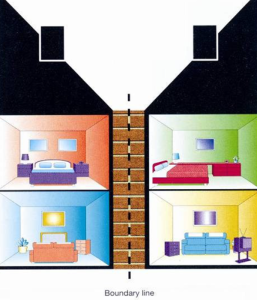
This image* shows a Part A party wall separating two buildings.
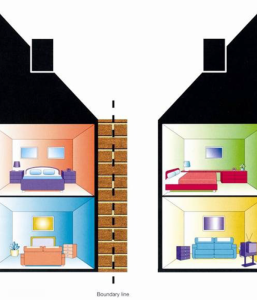
This image* shows a Part A party wall forming part of one building only.
Type B Party Wall
Type B party walls stand entirely on one person’s land, but an adjoining owner has a building enclosed by the same wall.
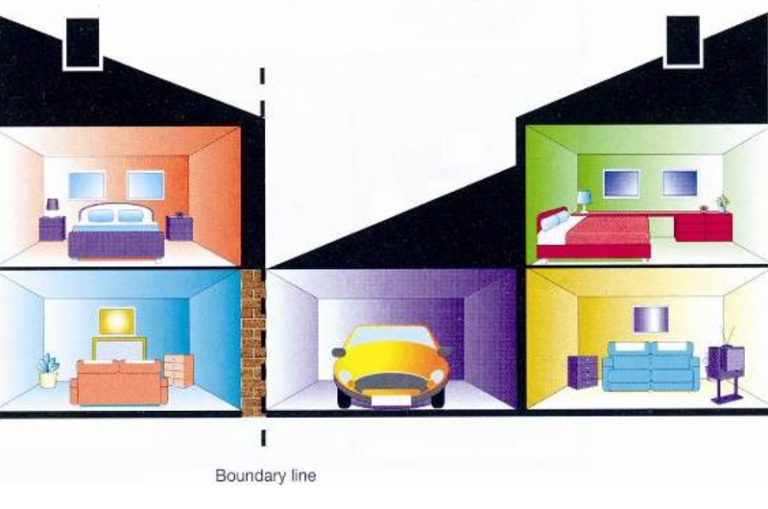
This image* shows a Type B party wall with a neighbour’s garage extension built up to the wall.
Party Fence Wall
A Party Fence Wall stands on a boundary but is not attached to a building.
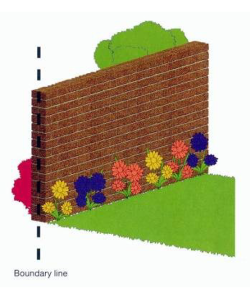
This image* shows a Party Fence Wall.
Party Structure
Party Structure is an umbrella term for all the above but also applies to horizontal structures, for example, floors and ceilings in a block of flats.
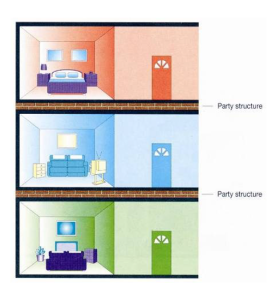
This image* shows a horizontal party structure.
What is the purpose of the Act?
The Act aims to address the problem of building works causing damage to an adjoining owner’s building, interrupting their use and enjoyment of the party wall or structure. It provides a dispute resolution procedure protecting the adjoining owner’s interests while giving the building owner the rights they need to carry out their work.
Party Wall Procedure
A building owner must give notice to all adjoining owners of any works caught by the provisions of the Act. The notice requirements vary depending on whether the work involves:
- works to an existing wall; or
- building a new wall or party fence wall; or
- excavating within three or six metres of the adjoining owner’s buildings (often colloquially referred to as the ‘Party Wall Act 3 metre rule’).
If your proposed works fall into any of the above categories:
- you must serve a party wall notice on every neighbouring property owner affected at least two months before commencing work; and
- once notice has been served, you must begin work within a year.
Once you have served notice, your neighbour(s) may either:
- give their consent to the works in writing; or
- object to the works in writing; or
- do nothing.
Party Wall Disputes
If 14 days pass from the service of your notice and your neighbour(s) has done nothing, a dispute is deemed to arise.
If a dispute arises, either expressly or because of your neighbour’s silence, the Act says you must appoint a surveyor. You can agree the instruction of a surveyor jointly with your neighbour, or each appoint your own. If your neighbour fails or refuses to instruct a surveyor, you may appoint one on their behalf. The surveyors will agree on a ‘party wall award’.
Party Wall Award
A binding party wall award is a legal document usually produced by an expert party wall surveyor. The award sets out:
- the permitted work.
- how and when the work should be carried out.
- who pays (and how much) for which part (including the surveyor’s fees).
A party wall award also documents the original condition of the adjoining owner’s land in case the work causes damage.
If you or your neighbour(s) do not agree with the party wall award within 14 days of receiving it, there is an appeal process to the County Court. To do so, you must file an appellant’s notice.
Neighbour begins work without an agreement
Many party wall disputes arise because a neighbour starts work without a party wall agreement. But you may find it surprising that there are no penalties for failing to serve notice. So, if your neighbour starts work without giving proper notice, your only remedy is applying to the court for an interim injunction forcing them to stop.
Party wall agreement after works completed
A retrospective party wall agreement is an award granted by a surveyor who is believed appointed under the Act for works already carried out. However, any award deemed to be retrospective is not legally binding under the Act. If both parties have agreed the terms of such an award, it’s a binding contract but not enforceable as an award.
See also: Court of Appeal considers the effect of failing to serve a Party Wall Notice
* These diagrams are reproduced under the terms of an Open Government Licence v3.0.



